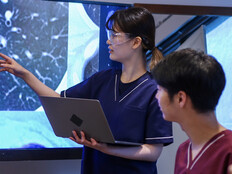How Technology Can Improve Math Comprehension
Mathematical truths are eternal. Alas, for many young students, math lessons sometimes are interminable.
It doesn't have to be that way. In rural Tennessee, technology deployed in conjunction with manipulatives, such as pattern blocks and snap cubes that help students understand math concepts, is enhancing math lessons for K–5 students.
The hope is to increase achievement in the Upper Cumberland region by making the subject interactive and engaging to a generation more familiar with using a mouse than pencil and paper. A three-year Math and Science Partnership grant awarded to Tennessee Technological University (TTU) by the state's Education Department has put a succession of technology products (Macbooks, digital cameras, camcorders, document cameras, LCD projectors and iPads) into the hands of 50 teachers. The grant has also funded training that teachers need to effectively use these tools in their classrooms.
"According to research, the traditional ways of teaching aren't working," says Dr. Holly Anthony, associate professor of mathematics education in TTU's Department of Curriculum and Instruction. Anthony wrote the grant proposal that secured the funds necessary to run the project with co-directors Dr. Wendy Smith (a math education consultant and statistician) and Sheryl Webb (a high school math teacher).
"Students today are engaged in technology, and if we can deliver mathematics in that sort of forum, then we can reach those kids," Anthony says.
In addition, three years ago the state revised all mathematics standards for K–12 education, which in part directed educators to leverage technology as much as possible in math instruction. "We saw this project as an opportunity to tap into that and hopefully open the door to more innovative ways of teaching mathematics," Anthony says.
Project Parameters
A total of 100 K–5 teachers from 11 of the 16 school districts that fall within TTU's service region participated in the project. The teachers were randomly divided into two groups: half to a control set that received technology and manipulatives but no training, and the rest to an intervention group. That group not only received the tools, but also spent six weeks and 16 Saturdays over the course of the three-year project at TTU to learn how to effectively use the materials in the classroom. The sessions were run by Anthony and her team, which also includes TTU faculty members Dr. Jane Baker and Dr. Leslie Suters.
TTU tested each group's content knowledge in the areas of academic emphasis, which are determined annually based on state teaching standards. Teachers were then tested before and after each school year to assess how beneficial it was to have the technology as well as intensive support from TTU instructors about how to apply the technology in the classroom.
Anthony says teachers in the intervention group have exhibited significant development in content knowledge for each individual area, compared with the control group, but cumulative results for the project are pending. She also is awaiting additional state student test data to determine if there has been a statistically significant performance impact on students.
"It is a risky thing to try something new with kids, so teachers do need support and training" if they're to be successful, she says. After all, some teachers have been educators for decades, and introducing technology into the process represents a huge change from the way they are accustomed to teaching. Before introducing any technology, Anthony and her colleagues spend months figuring out how to effectively integrate the technology into classroom instruction plans.

Anthony with team members Dr. Jane Baker (left) and Dr. Leslie Suters
Photo: Tamara Reynolds
It's the math content that drives how the technology will be used, not the other way around. That's critical.
"All too often technology is the shiny new thing, and people grab at it because it's shiny and new, versus what it can do for learning," says Michael Horn, executive director of education at Innosight Institute, a nonprofit think tank focused on how disruptive innovation can help solve problems in education and healthcare. "Being very clear about those objectives and having thought out the 'why' is the starting point," he says.
Serving Student Needs
Elementary school students need to learn about math concepts such as addition and substraction with regrouping, so the teachers in the intervention group have learned how to use AVerMedia's AVerVision CP355 document cameras to harness the power of interactive whiteboards, which all too often are treated simply as fancy chalkboards or as a way to display PowerPoint presentations. Connecting the CP355 to an interactive whiteboard can offer close-up views of a teacher's work with a manipulative set.
What's more, the teacher or the students can annotate over the document camera image on an interactive whiteboard. "Often teachers weren't thinking about putting [the interactive whiteboard] in students' hands," says co-director Smith. "It's a paradigm shift to think about how to use it in new ways."
And once teachers are exposed to the possibilities, they're encouraged to explore other uses for their whiteboards, even separate from the document cameras, Anthony says.
Cathy Henson, a fourth-grade teacher at Hickman Elementary in Davidson County, says she's hooked on the document camera because of how easy it is for the students to see the manipulatives she often uses. "The kids are engrossed by being able to see what is under the document camera blown up on a great big projector or screen, and they love it," she says. "They pay closer attention because they can see it better."
Plus, the document camera offers push-button ease of use, which lets her show the hands-on manipulatives on-screen and then, with a flick of her finger, switch to show a software program about using virtual manipulatives on the same screen.
24 frames per second
The still-image capture speed of the AVerMedia AVerVision document camera
SOURCE: AVer Information
"They make the connection, so that when we go into the computer lab they love using the virtual manipulatives," Henson says. "It reinforces what we are using concretely in the classroom."
Anthony says she and her team hope the results of the project will help them secure additional funding to continue the level of support they've been able to provide the teachers the past three years. "We hope to show it had a positive impact and that we'll be able to continue to bring in teachers and support them," she says.
But if not, TTU's Millard Oakley STEM Center for the Teaching and Learning of Science, Technology, Engineering and Mathematics offers ongoing professional development support to educators in its service regions, which naturally includes the teachers in the project. "So when this project ends, we'll continue to be involved with them," she says. "After three years we are actually quite a family, so we are going to stay in touch with these folks."
Making Math Movies
The technology from Tennessee's Department of Education grant includes Flip Video MinoHD Camcorders.
Dr. Jane Baker, a project instructor who specializes in early childhood education, says K–2 teachers can leverage that and other technologies to help youngsters understand the idea of multiple representations.
Take the concept of the number 14, for example. "They're going to create a 'math movie' with all different representations of 14. Maybe that's showing 14 pennies or the numeral 14 or the numbers '7+7' or the word 'fourteen' written out," she says. "This approach gets students to think outside the box, to see that there is more than one way to represent a concept. And if you can learn something in more than one way and represent knowledge in more than one way, you're more likely to retain it."
Dr. Holly Anthony, , associate professor of mathematics education in TTU's Department of Curriculum and Instruction, says her team introduced the idea of a geometry scavenger hunt as another possibility.
The hunt has students finding real-world items featuring geometric concepts such as acute angles, snapping digital photos of them and importing these to an interactive whiteboard. There, they can use software tools such as a protractor to measure and confirm that the angles on the objects are less than 90 degrees. Cathy Henson, a teacher at Hickman Elementary in Davidson County, adapted that idea to use with her third- and fourth-grade students, making it a springboard for a lesson on solids and flats.
"We showed them pictures from all around the places they frequent," she says. "They had a good time and paid attention to locating in the pictures all the different math terminologies. They were using some really rich vocabulary as they were looking at the pictures."
That's exactly the kind of learning that Dr. Wendy Smith, a math education consultant and statistician, likes to see. "When teachers think of a math concept they want to introduce, we want the first thing they think about to be something to do with this new technology versus going to a textbook and copying out pages to hand out," Smith says.
Jennifer Meadows, who teaches fourth grade and also serves as technology coordinator at Prescott South Elementary, can now teach to the standards strand by strand (numeration, for example, or measurements), rather than unit by unit as textbooks dictate.
"It's really gotten me away from mainly using the textbook. I think that was a security blanket before," she says. "But textbooks don't always hit all our standards, and if you just use that you won't meet all the students' needs."








